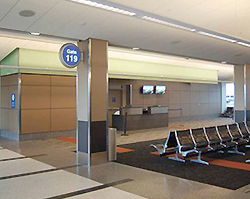
Another question I’m frequently asked: can a power amp be bridged to get the voltage swing for a 70.7-volt system? The answer is yes, but you may not want to use a 600-watt power amp to drive a system requiring only 150 watts, and you may not want to use a step-up transformer.
On the other hand, a standard 150-watt power amp at eight ohms will not deliver the required 70.7 volts unless it is bridged or outfitted with a step-up transformer.
Here is an example of how to bridge a power amp for 70.7-volt operation. Let’s say we have a distributed system requirement of 150 watts at 70.7 volts. This will require a power amp that delivers 150 watts per channel at eight ohms, resulting in an output voltage of 34.6 volts per channel. For a 70.7-volt system requiring 150 watts, load impedance is calculated at 32 ohms.
When this power amp is bridged, it sees only half the impedance load applied to it. For a 32-ohm load, each channel sees 16 ohms. Most manufacturers do not publish 16-ohm specifications, so to determine this, divide the 8-ohm rating in half. So in this example, a 150-watt at 8 ohms is 75 watts at 16 ohms. The voltage swing for 75 watts at 16 ohms is 34.6 volts, and with the power amp bridged, power and voltage outputs double. Thus after bridging this power amp, output of 70.7 volts and 150 watts is attained, close enough to adequately drive the system.
CHECK THAT SATURATION
Overdriving is a common mistake with distributed systems. If more than 70.7 volts (or 100 volts) is applied, step-down transformers may saturate, causing them to go from high impedance to an almost dead short. Not only will sound quality suffer immensely, but the power amp may fail. And be extra careful that this does not happen if you are bridging a power amp. The channel outputs will be shorted together if saturation occurs, and this is not good!
Step-up transformers can also be saturated if too much power is applied to the primary. When selecting a step-up transformer, be sure to match the power output of the power amp to the primary impedance of the transformer. (Most primaries are either 4 ohms or 8 ohms.)
Another issue of which to be aware is the combined frequency response of a loudspeaker and step-down transformer. Most only go flat to 120 Hz. To conserve power from the power amp while also avoiding low-frequency saturation, place a high-pass filter on the input of the power amp, which will limit its low-frequency response. It is recommended to use high-pass filter rated at 80 Hz to 120 Hz, 12 dB to 24 dB.
Always remember that 70.7 volts or 100 volts is the maximum voltage to be applied to the step-down transformer. Further, a distributed system design should operate between 50 and 75 percent of its total capability, allowing for additional headroom when needed and preventing potential transformer saturation.
To attain a distributed system offering excellent intelligibility and quality background music reproduction, it’s essential to have a good understanding of all the pieces in the chain as well as the potential problems that may occur.
Jeff Kuells is an audio engineer and audio manufacturing consultant and was previously director of engineering for a major amplifier manufacturer.
